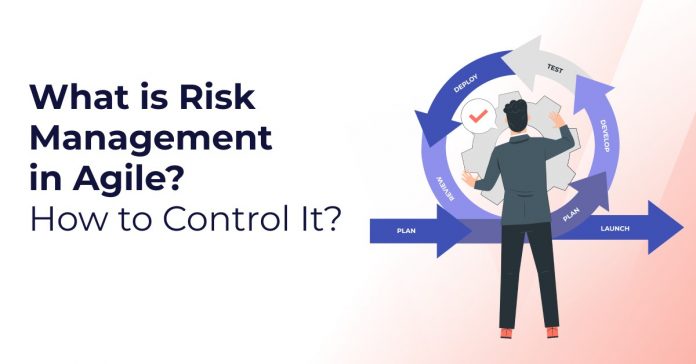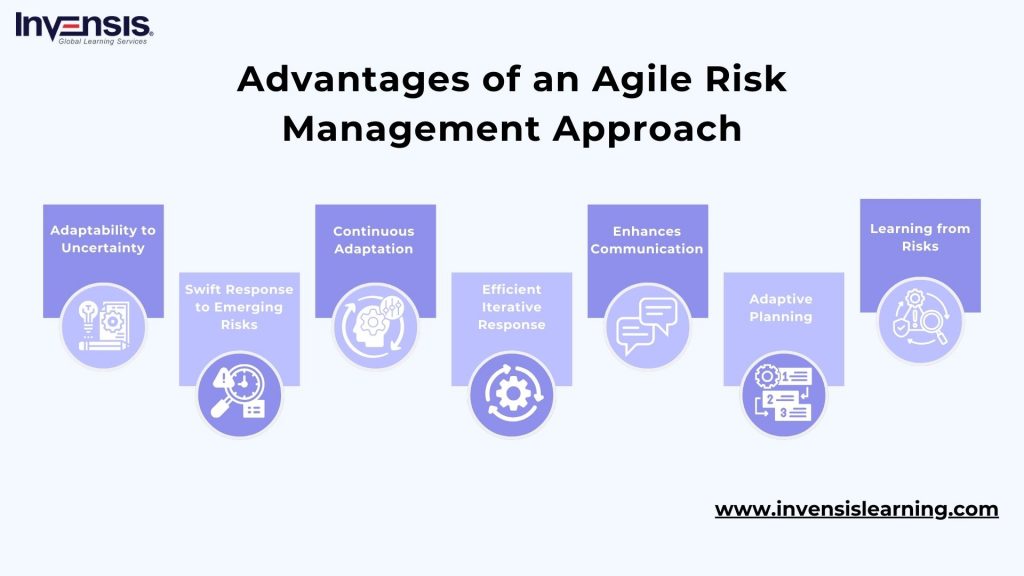
In project management certification courses, Agile methodologies have emerged as a dynamic and responsive approach to handling complex tasks. However, even in the world of Agile, where adaptability is a cornerstone, the element of risk remains constant.
The success of any project, regardless of its Agile nature, depends on the ability to identify, assess, and effectively manage risks.
This blog provides professionals with information about the complexities of risk management in Agile and actionable insights on addressing challenges and fostering an efficient project delivery process.
Let’s embark on this journey to empower your Agile endeavors with the knowledge and tools needed to stay ahead of the curve in an ever-changing business environment.
Table of Contents
- Understanding the Risk Management Process
- Risk Identification in Agile Risk Management
- Risk Assessment in Agile Risk Management
- Risk Response in Agile Risk Management
- Risk Review in Agile Project Management
- Advantages of an Agile Risk Management Approach
- Structuring an Agile Project for Risk Management
- Conclusion
Understanding the Risk Management Process
Risk management is a crucial aspect of project and business management, aiming to identify, assess, and mitigate potential uncertainties that could impact objectives. The risk management process comprises several key steps to ensure a systematic approach to handling risks.
Here’s a breakdown of the fundamental elements:
- Identify the Risk: This initial step involves compiling a comprehensive list of potential risks by engaging stakeholders, project teams, and subject matter experts
- Analyze the Risk: After identification, each risk is thoroughly examined to understand its nature and potential consequences
- Evaluate the Risk: Risks are prioritized based on impact, often using risk matrices and quantitative analysis techniques
- Treat the Risk: Once prioritized, strategies are developed and implemented to manage or mitigate the identified risks. This may involve risk avoidance, mitigation, transfer, or acceptance
- Monitor and Review the Risk: Continuous monitoring ensures the effectiveness of implemented strategies, with regular reviews to track progress, evaluate impact, and make adjustments as needed
By following these steps, organizations can enhance their ability to proactively manage uncertainties, ultimately contributing to the successful achievement of their objectives.
Risk Identification in Agile Risk Management
In Agile risk management, identifying risks is crucial for effective control and mitigation. Agile practitioners use techniques like exhaustive risk checklists and document reviews. The project manager encourages collective risk identification.
- Early Requirements Analysis
- During discussions on project requirements, team members think about potential implementation risks, setting the stage for proactive problem-solving.
- Precise Estimation in Agile Planning
- In Agile planning, the team carefully figures out each task’s size, paying close attention to details. This helps them understand and deal with any potential challenges more effectively.
- Risk Awareness in Iteration Planning
- Risks are integrated into iteration planning, with the team selecting work aligned with their confidence level to reduce the risk of failure.
- Proactive Communication in Stand-Up Meetings
- Team members raise issues impacting their work during stand-up meetings, engaging in collaborative discussions to implement mitigating actions promptly.
- Stakeholder Collaboration in Iteration Reviews
- Regular stakeholder engagement during iteration reviews facilitates discussions on and clarification of risks, ensuring alignment between the team and stakeholders.
- Reflective Practices for Risk Assessment
- The Agile team uses reflective practices, evaluating project states and experiences during each iteration to risk assessments and adapt strategies.
By adhering to these guidelines, the Agile team establishes a foundation for risk identification, enabling a proactive and adaptive response to potential challenges throughout the Agile project’s lifecycle.
Risk Assessment in Agile Risk Management
Following the identification of risks in Agile project management, the subsequent crucial step is risk assessment. In Agile, acknowledging broad risk categories, including business, technological, and logistical risks, proves beneficial.
One popular categorization framework is PESTLE, which stands for Political, Environmental, Social, Technological, Legal, and Economic risks. Agile practitioners employ effective risk assessment techniques to manage uncertainties in Agile project management:
-
Risk Census
Agile teams utilize a risk census, a straightforward framework for analyzing project risk exposure. Each risk is evaluated based on probability and impact, considering factors like time and cost. The incremental risk exposure is calculated by multiplying probability and impact, providing an overall risk assessment for the project.
-
Risk Board
A risk board is an information radiator, transparently displaying identified risks, their probabilities, and impacts. Agile team members and the project manager regularly review this board during stand-up meetings to stay informed about potential risks and their status.
-
Risk Burn Down Chart
The risk burn-down chart is a graphical indicator that illustrates trends in project risks. This visual representation displays risk exposure, impact, and response over time. Agile teams use this chart to track progress in controlling risks, providing insights into achieved milestones and pending risk mitigation efforts.
In Agile risk assessment, these techniques contribute to a dynamic and transparent process, enabling the Agile team to adapt to changing circumstances and proactively manage risks throughout the project lifecycle.
Risk Response in Agile Risk Management
In Agile risk management, once risks are identified and evaluated, the next important step is developing and implementing risk responses. Agile practitioners employ various strategies to respond to potential uncertainties and challenges.
Here are some key considerations in the risk response phase:
-
Avoid
If a particular task or story is difficult, the Agile team may avoid it by removing it from the project backlog. However, this is only sometimes possible, and the decision depends on the story’s importance to the overall project.
-
Mitigate
The mitigation strategy involves the Agile team working to reduce the impact or probability of risks. For example, if the team understands their “velocity,” they can better predict the amount of work they can handle during each iteration.
-
Transfer
Using the transfer strategy, the team shifts the risk to another party. Commonly, this is seen in outsourcing, where specific tasks are assigned to a third party. However, it’s important to note that transferring risks doesn’t eliminate them, and risks should be addressed.
-
Accept
With the accepted strategy, the team consciously acknowledges and deals with the risk as it arises. This strategy is typically employed for lower probability or impact risks, where the team is willing to accept and manage the uncertainties.
By integrating these risk response strategies into the Agile framework, teams can navigate uncertainties more effectively, ensuring a proactive and adaptable approach to challenges throughout the project lifecycle.
Risk Review in Agile Project Management
In Agile project management, a “Risk Review” is a vital practice in systematically evaluating project risks.
This forum or meeting involves reassessing the probability and impact of existing risks and identifying any new risks that may have emerged.
Platforms such as daily stand-up meetings, planning sessions, and Scrum-of-Scrums are valuable forums for conducting risk reviews in Agile project management.
This ongoing process ensures that the team remains attentive and responsive to potential challenges, contributing to the overall success of the Agile project.
Advantages of an Agile Risk Management Approach
An Agile risk management approach offers several advantages that contribute to the overall success and adaptability of projects.
Here are the key benefits associated with adopting an Agile risk management approach:
- Adaptability to Uncertainty: Agile’s flexibility aligns well with the inherent uncertainties in projects, making it adept at handling risks during ongoing work
- Swift Response to Emerging Risks: The adaptable nature of Agile enables teams to respond quickly and effectively to emerging risks as the project progresses
- Continuous Adaptation: Agile’s incremental nature allows for continuous assessment and adaptation, ensuring vigilance and responsiveness to risks throughout the project
- Efficient Iterative Response: Agile’s iterative cycles provide natural breakpoints for evaluating and mitigating risks, contributing to more efficient risk management
- Enhances Communication: Agile’s emphasis on communication ensures effective sharing of risk-related information among team members and stakeholders
- Adaptive Planning: Agile’s adaptive planning allows teams to modify plans based on changing circumstances, including the identification of new risks
- Learning from Risks: Agile fosters a culture of continuous improvement, viewing risks as opportunities for learning and refinement
This approach enables teams to navigate uncertainties with agility and enhances the project’s overall success.
Structuring an Agile Project for Risk Management
Structuring an Agile project for effective risk management is crucial to ensure adaptability and success. Here are key steps and considerations for structuring an Agile project with a focus on risk management:
-
Prioritize High-Risk Items Early
Align the Product Backlog to address high-risk items early in the project. This strategic structuring allows the team to tackle challenges, ensuring that potential risks are identified and managed proactively.
-
Risk Evaluation “Spikes”
In situations where there is significant uncertainty surrounding high-risk items, consider implementing a “spike.” A spike is a focused, time-boxed activity to evaluate and understand the associated risks. This allows the team to gather insights without impacting the ongoing project, contributing to informed decision-making.
Conclusion
Risk management is a fundamental and dynamic aspect of Agile project management, ensuring that teams navigate delays effectively and deliver successful outcomes.
The iterative nature of Agile methodologies provides a framework for proactive risk identification, assessment, and control throughout the project lifecycle.
By prioritizing early intervention, adaptability, and continuous monitoring, Agile teams can respond to challenges and keep the project successful. Transparent communication, collaboration, and a commitment to learning from experiences further enhance the effectiveness of risk management in an Agile.
Ultimately, mastering the art of risk management in Agile is integral to achieving stability, adaptability, and success in the project development landscape.
Ready to take your project management skills to the next level? Explore Invensis Learning’s AgilePM Certification courses and master the principles of Agile project management. Enroll now to accelerate your professional journey with expert-led training and certification.
















